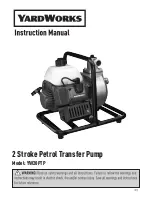
6.5.2 Venting
CAUTION
Risk of injuries due to contact with vacuum when venting
While venting the vacuum pump there is a risk of minor injuries due to the direct contact of body parts
with the vacuum, e.g. hematomas.
► Do not fully unscrew the venting screw out of the housing during venting.
► Keep a distance from automatic venting device, such as venting valves.
NOTICE
Damage to the turbopump due to non-permissibly fast pressure rise during venting
Non-permissibly high pressure rise rates place a significant load on the rotor and the magnetic bear-
ing of the turbopump. During venting very small volumes in the vacuum chamber or the turbopump,
there is a risk of uncontrollable pressure rises. This causes mechanical damage to the turbopump,
including potential failure.
► Observe the prescribed maximum pressure rise speed of
15 hPa/s
.
► Avoid manual and uncontrolled venting of very low volumes.
► Where necessary, use a venting valve from the Pfeiffer Vacuum range of accessories.
Manual venting
Manual venting describes the standard process for venting the turbo pumping station.
1. Ensure that the vacuum system is shut down.
2. Open the black venting screw on the turbopump by one revolution maximum.
3. Wait for pressure equalization to atmospheric pressure in the vacuum system.
4. Close the venting screw again.
Use a Pfeiffer Vacuum venting valve
The Pfeiffer Vacuum venting valve is an optional accessory for installation on the turbopump.
The venting valve is normally closed. Control is via the turbopump electronic drive unit, and configura-
tion of parameters
[P:012]
and
[P:030]
. In the event of a power failure, the turbopump continues to de-
liver sufficient energy during its run-down period to initiate a proper venting process. When power is re-
stored, the venting process is interrupted.
► Switch off the turbopump.
– The venting process starts automatically.
Venting speed [P:720] Venting duration [P:721] Venting duration in the event of a power
failure
50 % of rated speed
3600 s
3600 s
Tbl. 10:
Factory settings for delayed venting in turbopumps
General information for fast venting
We recommend fast venting of larger volumes in 4 steps.
1. Use a Pfeiffer Vacuum venting valve for the turbopump, or match the valve cross-section to the
size of the recipient and maximum venting rate.
2. Vent the vacuum system with a maximum rate of pressure rise of
15 hPa/s
for a duration of 20
seconds.
3. Then vent the system with a second venting valve of any size; for example, directly at the vacuum
chamber.
4. Wait for pressure equalization to atmospheric pressure in the vacuum system.
Operation
36/58
















































